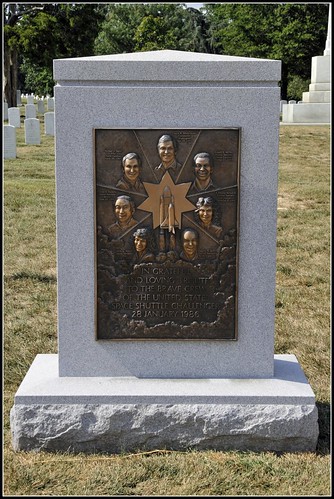Lastest Decision Making Movie News
Challenger Memorial and Grave

Image by Tony the Misfit
The Space Shuttle Challenger disaster occurred on January 28, 1986, when Space Shuttle Challenger broke apart 73 seconds into its flight, leading to the deaths of its seven crew members. The spacecraft disintegrated over the Atlantic Ocean, off the coast of central Florida, United States at 11:39 a.m. EST (16:39 UTC).
Disintegration of the entire vehicle began after an O-ring seal in its right solid rocket booster (SRB) failed at liftoff. The O-ring failure caused a breach in the SRB joint it sealed, allowing pressurized hot gas from within the solid rocket motor to reach the outside and impinge upon the adjacent SRB attachment hardware and external fuel tank. This led to the separation of the right-hand SRB’s aft attachment and the structural failure of the external tank. Aerodynamic forces promptly broke up the orbiter.
The crew compartment and many other vehicle fragments were eventually recovered from the ocean floor after a lengthy search and recovery operation. Although the exact timing of the death of the crew is unknown, several crew members are known to have survived the initial breakup of the spacecraft. However the shuttle had no escape system and the astronauts did not survive the impact of the crew compartment with the ocean surface.
The disaster resulted in a 32-month hiatus in the shuttle program and the formation of the Rogers Commission, a special commission appointed by United States President Ronald Reagan to investigate the accident. The Rogers Commission found that NASA’s organizational culture and decision-making processes had been a key contributing factor to the accident. NASA managers had known that contractor Morton Thiokol’s design of the SRBs contained a potentially catastrophic flaw in the O-rings since 1977, but they failed to address it properly. They also disregarded warnings from engineers about the dangers of launching posed by the cold temperatures of that morning and had failed to adequately report these technical concerns to their superiors. The Rogers Commission offered NASA nine recommendations that were to be implemented before shuttle flights resumed.
Many viewed the launch live due to the presence on the crew of Christa McAuliffe, the first member of the Teacher in Space Project. Media coverage of the accident was extensive: one study reported that 85 percent of Americans surveyed had heard the news within an hour of the accident. The Challenger disaster has been used as a case study in many discussions of engineering safety and workplace ethics and inspired the 1990 television movie, Challenger.
Crew:
One thing made this mission unique. It was scheduled to be the first flight of a new program called TISP, the Teacher In Space Program. The Challenger was scheduled to carry Sharon Christa McAuliffe, the first teacher to fly in space.
Selected from among more than 11,000 applicants from the education profession for entrance into the astronaut ranks, McAuliffe was very excited about the opportunity to participate in the space program. "I watched the Space Age being born and I would like to participate."
Besides McAuliffe, the Challenger crew consisted of mission commander Francis R. Scobee; pilot Michael J. Smith; mission specialists Ronald E. McNair, Ellison S. Onizuka, and Judith A. Resnik; and payload specialists Gregory B. Jarvis. Christa was also listed as a payload specialist.
Remains:
The remains of the crew that were identifiable were returned to their families on April 29, 1986. Two of the crew members, Dick Scobee and posthumously promoted Capt. Michael J. Smith, were buried by their families at Arlington National Cemetery at individual grave sites. Mission Specialist Lt Col Ellison Onizuka was buried at the National Memorial Cemetery of the Pacific in Honolulu, Hawaii. Unidentified crew remains were buried communally at the Space Shuttle Challenger Memorial in Arlington on May 20, 1986.
source: wiki and space.about.com/cs/challenger/a/challenger.htm
Congratulations and a remembrance on the 40th Anniversary of the Apollo 11 mission – the first manned lunar landing, July 20,1969.
Watching smoking scenes in movies lights up smokers’ brains
Washington, Jan 19 : New research shows that seeing an actor in a movie light up a cigarette triggers smokers’ brains to plan the same motions.
Read more on New Kerala
